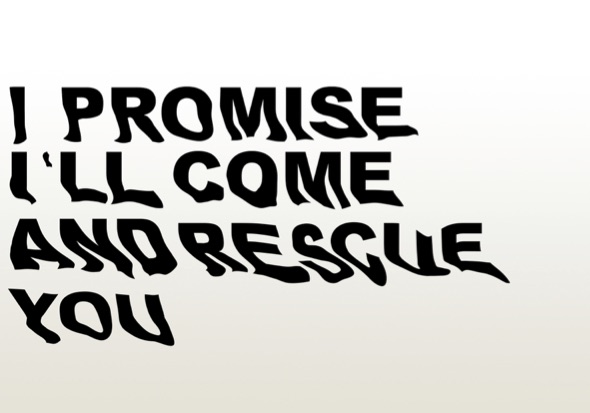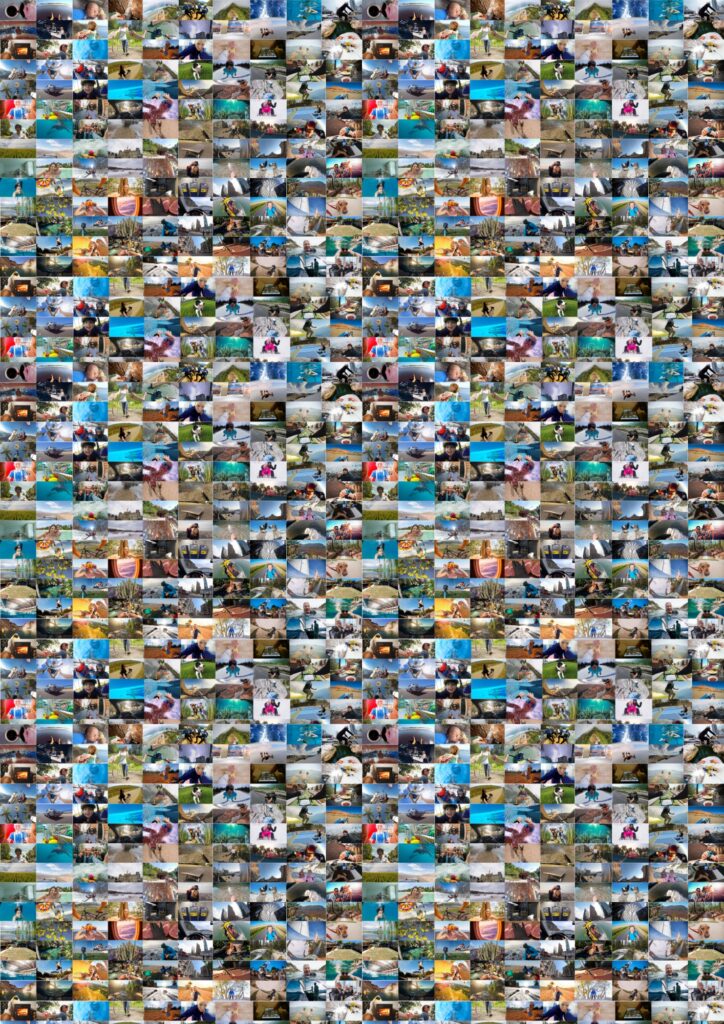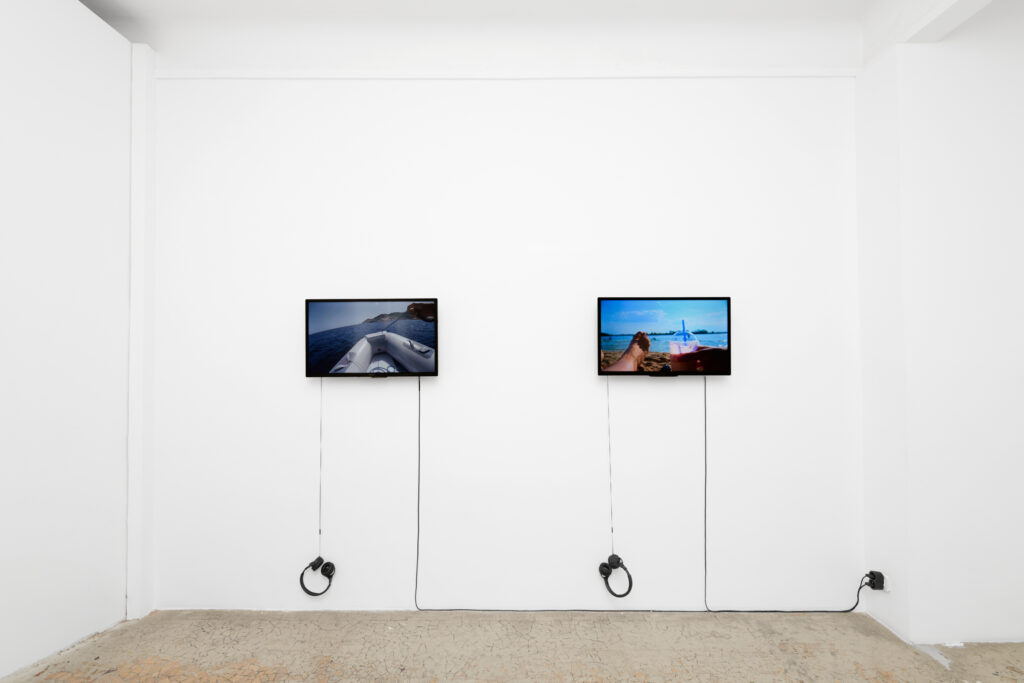
Galerie anne barrault is delighted to host Vimala Pons’ first solo exhibition.
A multi-media and trans-disciplinary artist, Vimala Pons has a background in competitive sport, art history, cinema and music.
Known for her performative shows as well as her chiseled career as a film actress, all her work as an artist is based on emotional macro-introspection and the manifestation of imbalance in all its forms.
I PROMISE I’LL COME AND RESCUE YOU is a series of 40 videos, 2 minutes long each. These are short sequences shot from a subjective point of view. These images, retrieved from an online image bank, create a dialogue between mental and visual loops, mantra, self-persuasion and obsession.
For her first exhibition, Vimala Pons worked in close collaboration with Danse Musique Rhône-Alpes for the original music composition, mix and image editing.
_____________________
We had left the artist on stage, in a striking performance: balancing a car on her head, her face concealed behind a hyper realistic mask of Angela Merkel, Vimala Pons was engaged in a strip tease – slowed down by many layers of clothes – while delivering a long monologue, the memory of an unhappy love affair of the former chancellor.
This staggering scene, much applauded, shared and commented has remained as one of the most outstanding memories of the theatrical year.
But the astonishment left aside, the technical and acrobatic performance was not what we remembered, no more than the surprising talent of the artist as an imitator, nor her absurd humor, which sent the audience into a burst of laughter.
What remained and was far beyond the spectacular scope of the event, was the existential abyss opening up in front of us: this enigmatic and ludicrous chimera who strip teased on the stage in a chaotic and unsteady urgency, was sharing with us a deep and metaphysical solitude: that of the learning of desire, the gaze of others, and the absence of a response to this desire. The exhibition of the artist’s body and skills actually disguised a personal journey deep into the expression of inner distress.
The dramatic path and the theatrical device displayed to lead to this emotion remain one of the most unexpected and singular trajectories ever seen on stage. This exposure, through its radicalism and singularity, extended other ones, just as mysterious and enigmatic, which have punctuated art history: from Pina Bausch to Marina Abramovic, through Francisco Goya and Marcel Duchamp.
Today, the artist’s imaginative world goes on unfolding through a language other than that of stage performance: Vimala Pons presents, at Galerie Anne Barrault, a series of very short videos, hung on the walls like as many paintings in the exhibition space. Each of these video shots comes from image bank catalogs, the contents of which are produced on an almost industrial scale and are made up of very colorful, moving images filmed in short focal length initially for commercial use – mainly advertising.
This imagery of repetitive stereotypes (about heterosexual couple, the corporate world or the family unit…) are initially produced in order to arise the desire to buy or consume, by integrating promotional editing for goods or an ideology.
Through text, music and editing, the artist reexamines these images of the consumerist happiness of the Californian middle class and offers a gritty, hallucinatory reading. In her ownway, she haunts the artificiality of situations, putting back everything that the production process has evacuated: irrationality, desire, doubt, neurosis and trauma.
Here, the vacuity of the promotional staging becomes the background of a fragile, longing and delirious mankind, in which the narrator’ story, in a maelstrom of inner voices, makes consuming, cruelty, entertainment, joy, narcissism and death drive collide. Somewhere between Lettrist 2.0 cinema and theater of the absurd, Vimala Pons, for a while, quits performance to become a video artist and enter the images as she enters her characters: by breaking in.
Clément Gogitore

« I PROMISE I’LL COME AND RESCUE YOU »
It’s the most beautiful declaration of love you can make to someone or something. It’s a promise that must be made, but can never be fulfilled. And that’s the beauty of it. It’s not actions that save, it’s promises. Love is about growing something in yourself that protects the other person from yourself. Trying to save someone from themselves is a beautiful promise.
Recovering existing images or working with everyday objects has always been my approach. Looking at an object and writing for it, scrutinizing its particularities, observing to exhaustion what intrinsically defines it and what we don’t notice at first glance.
Through this video work, I wanted to continue this research and transform it; to watch for signs of the discrepancy between what we see, what we are given to see, and what we think about it.
The principle of post-synchronization has always been a way of writing for me. It allows to twist reality by means of an artificial technical process that organically happens to us all the time: to render synchronous a thought and an image that generally don’t go together. It’s a state of magnetic observation, somewhere between contemplation and investigation. All the work lies in finding the right balance between two borrowed things that collide. Just like in love. Post-synchronization was also the technique I used as preparatory work for my latest show, premiering in January 2022: “Le Périmètre de Denver”. “I PROMISE I’LL COME AND RESCUE YOU” is also a way of giving voice to a physical act, using the principle of dubbing, the rhythm of the gestures generated by its action and the narrative it induces. From the purest illustration to the degradation of coherence, the narrative composed by these 40 videos will take many different paths. The break in tone multiplies the echo that one video offers to another.
For this first exhibition, my research focused on “clichéd” images retrieved from iStock. I scrutinized the off-field they suggest, the background action, or the inverted image they induce: in other words, I scrutinized their other story, their flaw. I wanted to use this flaw as a starting point for composing these inner voices and their music.
The music was composed by DMRA. DMRA is a cross-disciplinary artist. His work functions through subtle borrowings from certain forms of mainstream music, and his compositions play with texture as narrative, constructing a sound image that he never ceases to subvert.
In composing this project, DMRA created music that delicately supports the state of contemplation induced by visual repetition and slow motion. As music cannot be separated from writing, DMRA has shaped the image editing and writing orientations of these 40 videos. It’s a true collaboration.
“I PROMISE I’LL COME AND RESCUE YOU” is the sum of stories invented through gesture, task or sporting activity.
Are we defined by our actions? Do our actions define us?
I tried to understand how the body and the mind can at times live completely separate lives. While writing, I sought to achieve a state of light hypnosis created by these loops. Looking at them over and over again changes our interpretation. Mental images exert a magnetism on us, alternately creating or destroying the meaning allotted to our lives. I decided to expose what drives me to write: objects and actions.
I applied myself to reinterpreting the significant forces contained in everyday physical situations, and making them speak a different language.
Why video?
The trigger was the discovery of Clément Cogitore’s “The Evil Eye” and Douglas Gordon’s “Monodramas”. I was very struck by these two very different works. When I saw them, I thought of astronaut David Wolf’s words on his return from his 120-day voyage on the Mir station: “Your sensibilities are so heightened because they were absent for so many months.” These two films had a huge impact on me.
The works of two other video artists carried me through this project: those of Alex da Corte and Rachel Rose.
“The video was a place where I could be more aware, sensitive to what I had experienced.” Rachel Rose.
“Video can live in places where object can’t. The burden of object can be to much.” Alex Da Corte.
I see video as a way of understanding who we are, as an introspective tool that allows us to see ourselves as test subjects for the rest of humanity. Video art isn’t a way of expressing what you are, it’s a way of searching for what we all are. It’s a way of sharing, not a way of being original. The art of acting is my art. The art of balance is my art. It’s interpretation. In one case the interpretation of words, in the other the interpretation of gravity. Interpretation is our most powerful power. Interpreting reality is an art, the only one. It’s what drives us to write our lives one way or another. And reinterpreting is always the right thing to do. Reinterpretation is metamorphosis.
Vimala Pons, March 2024
 ___________________
___________________
Vimala Pons, the shock
There is no great art without risk-taking. What most artists symbolically risk when composing their works, (but this symbolic act is real from a psychic point of view), Vimala Pons risks it twice, since she risks it clearly on stage (but this real act is totally unreal from a psychic point of view). This is perhaps due to the Indian metaphysics strange fairies she grew up with. To know that experience is also Maya, illusion, may have given Vimala Pons this detachment, which allows her to do nearly anything she wants with her body, without fear or shaking. Unlike the title of Chloé Delaume’s novel, she is a woman with someone inside, except that it is someone else. Vimala is a person inside her own person. She is a person whose person is a machine she can manage, a little as if she was driving a car.
Then, the shock was Le perimeter de Denver, in 2021. Vimala Pons was on her own, but going through so many physical transformations that you had the feeling of watching a whole company perform: the Vimala Pons Septet. Characters changes by stripping, accents changes, uninterrupted monologues: the necessary concentration required to perform both these feats of balance and this virtuoso acting turns the vehicle Vimala Pons controls into a kind of supersonic autopilot one. Vimala Pons is Arjuna, the warrior with Krishna as his coachman, who takes him to the great sacred war against forms – against conditioning and determining.
As to the story, it is a murder mystery but also a transversal, dense and complex reading of contemporary psychology concerning lies. It is, once more, the comic and poetic power of literality: the title refers to the space offered by small lies, which creates the “ first avatar of self”, starting to live beside us. But then, the show explores every possibility of this space. The story is set in Brighton, in 2008, in a thalassotherapy hotel. Someone is killed. The victim is a “digital contributor “, that is to say, a troll. He or she is therefore a person who has used his or her false identity and his or her forging of lies, to the point where it could be said that he or she did not exist any more as an individual before he or her murder. He or she is a dead person who was already dead, but not in the sense of moksha, the Hinduism or Buddhism liberation. The troll has certainly no longer a personality, but it has not overcome its ego to reach infinite, omnipresent, incorporeal, transcendent and immanent reality, on the contrary. The troll ha no longer a personality, in the sense that nothing else than the ego can exist within it: no infinite reality, no transcendence or immanence, nothing. If in Indian metaphysics, Self is distinguished from Ego, like Krishna is distinguished from Arjuna, or consciousness is distinguished from the mind, in cybernetic space we are dealing only with Egos, with no access to self. They are beings freed by nothing, given up to the darkest passions. Kali Yuga already exists, but parallel to us, in computers. Those who live in computers, spending their time on social networks, writing and replying to comments, fighting by fake news, malicious gossip and mockery, do live the end of the world.
Is it again India that has enabled Vimala Pons to understand so well how the notion of avatar used in cybernetic language (the transposition of an individual into a digital identity) is different, indeed antagonistic, from the original one in Indian metaphysics (the divinity taking a corporeal form)? And how this non-identity of the cybernetic creature is opposed to the access, through the negation of forms or the awareness of their limitations, to an impersonal awareness leading up to an infinite plenitude? The troll, with no physical life, its motionless body reduced to a hand typing on a keyboard, holding a mouse or moving on a track pad, believes in its omnipotence, whereas it does only exist in a negative way, by depriving others of their power. On the opposite, Vilama Pons ‘extremely difficult balancing exercises, switching from a body to another, from an identity to another, enable her to reach and go beyond forms. Her inclination to take risks elevates her to the artist’s humbleness practicing, every evening in front of her audience, a game with her own death; hence the essential characteristic of her art. The more human beings will get lost in the dark labyrinths of their psyche, the more they will need artists, who will blow up this labyrinth and show them that illusion exists even more in life itself. The more the media and Internet world will consume human mind, the more mankind will need live shows to be reminded that life exists only in the true experiment of risk and the physical confrontation with what is impossible.
Pacôme Thiellement
extract from the text Le Choc Vimala, 2023
Vimala Pons’ exhibition is supported by ![]() Centre national des arts plastiques,
Centre national des arts plastiques,
the Villa Belleville and the Plateforme 2 Pôles Cirque in Normandie I La Brèche in Cherbourg for the residencies.
Production : galerie anne barrault & TOUT ÇA / QUE ÇA.
Team: Vimala Pons (writer, director and voice-over), Danse Musique Rhône-Alpes (original music composition, mix and editing), Arnaud Pierrel (video post-production), Adeline Ferrante (artistic coordination and production), Mathieu Hilléreau (administration, production)
Our sincere thanks to Vimala Pons, Adeline Ferrante _ TOUT ÇA / QUE ÇA, Mathieu Hilléreau – Les Indépendances, Loup GanGloff, Clément Cogitore, Pacôme Thiellement, Chloé Siganos, the CENTQUATRE-Paris.

